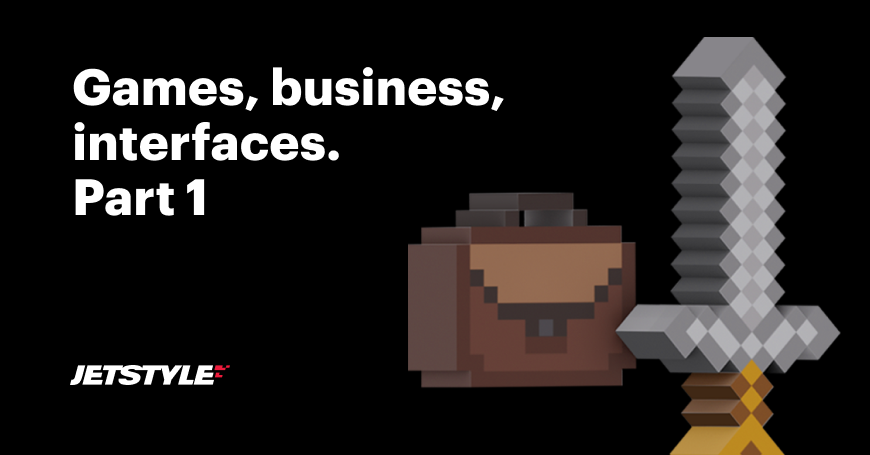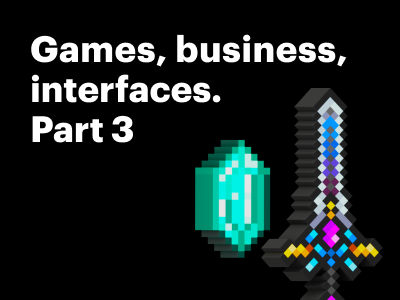30 July 2021
Games, business, interfaces. Part 1: What is a game
This article is the first part of a series about experience design in understanding wider than in interfaces, from our CEO Alexey Kulakov. It is about games, their features and types. You can think of this as a theoretical framework that will help you read the following parts, where we will tell you how the game metaphor is applied in the development of anything.
The entire series of articles consists of three parts:
-
the first part – this one – is about what a game is, what types of games exist and what are their main features,
-
the second is about the tools from games that can be used when designing interactions,
-
the third is about the parallel between games, UX design and business.

Some classic definitions
Let's take a look at what is commonly called a game.
A game is a series of interesting choices.
This definition is by my favourite game designer, Sid Meier, who created Civilization.
In business, we don't want to get into a situation where the choice is interesting. We want the choice to be unambiguous. An interesting choice is complicated, it is easy to make mistakes, and this is not what we usually want in business.
And it seems that this is not the situation in which we should put the user. For example, if you think of an interface as a series of interesting choices, then, in most cases, it will be an ineffective solution. Unless it's Tinder.
A game is a voluntary attempt to overcome unnecessary obstacles – Bernard Suits, philosopher.
People come to the game on purpose to feel the pleasure of being able to overcome obstacles. The obstacles themselves are artificial, but the experience of overcoming obstacles is real. This definition looks more like a business than an example with complicated choices. Especially if the business is somehow stupidly organised. But still, neither in the interface nor in business, we try not to make unnecessary obstacles. Although, if we look at it, we will find many exceptions, we will talk about them a little later.
A free activity standing quite consciously outside "ordinary" life as being "not serious," but at the same time absorbing the player intensely and utterly. It is an activity connected with no material interest, and no profit can be gained by it. It proceeds within its own proper boundaries of time and space according to fixed rules and in an orderly manner."
This is the longest and most classic definition of a game by the philosopher Johan Huizinga. Nobody can remember it, and neither can I. Therefore, I highlighted in it those things that seem important to me.
Signs of a game
Let's extract from these definitions the signs of the game applicable to business tasks.
-
The game takes place within the boundaries of the "magic circle" – it is outside of real, ordinary life
A terminally important sign, without which a game is not a game: people must understand where it begins and where it ends. In the slang of the developers, this is called "the boundaries of the magic circle": when someone enters the game, they understand that they are entering a space that is built according to certain rules, accept these rules and know that they can get out of there.
-
Participation in the game is voluntary, for the sake of pleasure
This and the first points are mandatory, everything else is subject to change. I'll explain why later.
-
The game itself is a manifestation of the player's freedom
If the participant, as an actor, is not allowed to make free decisions, if they cannot show their personality in action, the game zone will disappear. It will turn into a theatre or cinema, where nothing depends on them. In order for the game to remain a game, something needs to depend on the player. This something can be very extensive, as is the case in open-world games. Or very narrow, like in the Flappy Bird game, where all you can do is raise and lower the bird. The player should have some kind of freedom. And three more signs, which I will also talk about further.
-
The game is played for the sake of interest
-
The game has an internal order given by rules (or other agreements)
-
The game has unnecessary obstacles and risks that are taken for the sake of a win
Why am I paying so much attention to this? Everyone understands differently what a game is, they interpret it wider or narrower. And before approaching something (business, interface, institution) as a game, you should make sure to what extent it can be a game. My approach is something like this: the more of these signs, the more arguments in favour of approaching it as a game. And vice versa.
Types of games
There are all kinds of games, such as tabletop or computer games. I am involved in live-action games. This is when people simulate a situation and, in this situation, behave the way their characters would behave in it. At the same time, they determine their actions independently: they themselves look for a motive, and they themselves choose a method from the available arsenal.
Live-action games are held for fun and are divided into artistic and applied games.
Artistic games
Lately, my fellow game organisers and I have been looking at artistic games as art rather than entertainment, although it all started the other way around. Like any other art, artistic games are created so that the organisers, who are also called game masters, together with the players, realise their ideas and get joy from it. How is this similar to what we do in everyday life and in business? When we do a business, or a product, or some kind of non-commercial project, we, as organisers, have an idea. This idea will be embodied in the behaviour of other people. This behaviour is free, they will manage it themselves, within the framework that we offer them. And what we get is always created by the joint efforts of the business owners, the system and its participants.
Applied games
Applied games are made to benefit players outside of the game as a result. For example, so that they learn some skill in the game, design or try on some kind of interaction, try themselves in team roles and understand who is better at what. In addition, such a game is a way to voluntarily understand your attitude towards what is happening, to take your own position. This is the most useful thing that you can do with the help of the game as an applied tool because it is difficult to achieve the formation of a position in any other way. Well, apart from the real crisis in real life, but this is a very expensive way of learning.
Common features
1. In both artistic and applied games, we take a position – an attitude towards a situation as a result of past experience. When a person feels that the experience that happened to them can be used by them in the future. And they have a relation to this experience, form the intention of how to behave in such situations.
I go to games for good new questions that I am interested in answering. A good question is a question that you want to answer, but you can’t.
2. A game is a form of collective thinking and action. It is an experience that the players share together.
The time in the game is much denser than in life. In ordinary reality, a similar density of events occurs only in extreme situations, when everything is on fire or when there is a really big trouble and you have to jointly take a lot of urgent actions and experience a lot of emotions. You probably felt how, overcoming such difficulties, you become closer to each other. Maybe friends. Maybe a team. Why is this so? Because you have a shared experience – something that you went through together, to which you have a common relationship.
A game in this regard is a way to get the same effect without paying the same price. It is not necessary to risk your business, life and health. You can gain equally intense experiences through shared game experiences.
3. Prizes and awards, which include good questions, attitude, experience, joint decisions, didn't exist before the game. They were found by the players together, within the game, as a result of personal or collective experience. They didn't exist in finished form. This means that although the organisers of the game have a plan, it is still being transformed and rethought by the players. The players get from the game not exactly what the masters have put into it.
You cannot say before the game: “Well, look. You will find such conclusions in the game, just take them and that's it. " It doesn't work that way. More precisely, it is possible, but then the game is no more useful than less interactive tools. Because the conclusions that were not obtained as a result of your own experience are much less valuable. They don't belong to the one to whom they were given, but to the one who learned them from their own experience.
Now you know what a game is, and you can already find its signs in your business, product, and in life in general. And next time I'll tell you about the three main tools that I found in games and I myself use when designing interactions in business.
You might also like



